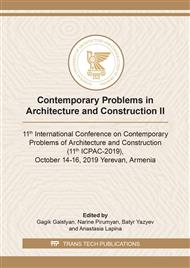[1]
G.P. Cherepanov, Brittle Fracture Mechanics, Nauka, Moscow, (1988).
Google Scholar
[2]
R.Ya. Popov, Concentration of Elastic Stresses near Stamps, Cuts, Thin Inclusions and Connections, Nauka, Moscow, (1982).
Google Scholar
[3]
I.I. Vorovich, V.M. Alexandrov, V.A. Babeshko, Non-classical Mixed Problems of Elasticity Theory, Nauka, Moscow, (1974).
Google Scholar
[4]
V.M. Alexsandrov, S.M. Mkhitaryan, Contact Problems for Bodies with Thin Coatings and Interlayers, Nauka, Moscow, (1988).
Google Scholar
[5]
R.Ya. Popov, On concentration of elastic stresses near a thin exfoliated inclusion. In Current problems of mechanics and aviation, dedicated to I.V. Obraztzov. (1980) 156-162.
Google Scholar
[6]
Development of the Theory of Contact Problems in the USSR, Nauka, Moscow, (1976).
Google Scholar
[7]
V.N. Akopyan, Mixed boundary-value problems on interaction of deformable solids with stress concentrations of different types, Gitutiun, NAS RA, Yerevan, (2014).
Google Scholar
[8]
Y.A. Antipov, N.Kh. Arutiunian, Torsion of an elastic ball with a disc-shaped crack, Izv. AN SSSR, MTT. 3 (1990) 30-67.
Google Scholar
[9]
Z.A. Davtyan, A.V, Gasparyan, Sh.A. Knyazyan, Contact problems on interaction of thin-walled elements with an elastic layer under torsion, Proceedings of the 9th International Conference on Contemporary problems of Architecture and Construction. (2017) 73-77.
Google Scholar
[10]
A.V. Gasparyan, Z.A., Davtyan, S.E. Mirzoyan, Lame problem for a multilayer viscoelastic hollow ball with regard to inhomogeneous aging, Proceedings of IV International Conference Topical Problems of Continuum Mechanics,. (2017) 57-58.
DOI: 10.1088/1742-6596/991/1/012018
Google Scholar
[11]
Z.A. Davtyan, A.V Gasparyan, Sh.A. Knyazyan, On contact interaction of an arbitrary number of elastic layers under torsion, Proceedings of the 8th International Conference on Contemporary Problems of Architecture and Construction. (2016) 73-76.
Google Scholar
[12]
Z.A. Davtyan, A.V. Gasparyan, A.V. Melkonyan, Torsion of a Compound Elastic Layer with a Coin-like Crack or a Rigid Inclusion, Proceedings of the 10th International Conference on Contemporary problems of Architecture and Construction. (2018) 107-111.
DOI: 10.4028/www.scientific.net/kem.828.18
Google Scholar
[13]
M. Sneddon, Fourier Transforms, I.L., Moscow, (1955).
Google Scholar
[14]
S.M. Mkhitaryan, On Two Mixed Problems Related to the Issues of Interactions of Various Types of Stress Concentrates and Massive Bodies under Anti-plane Deformation, Mechanics of Deformable Bodies, NAS RA. (1993) 129-143.
Google Scholar
[15]
R.Ya. Popov, On application of Jacobi polynomials to the solution of integral equations, Izv. Vuzov, Mathematics. 4 (1966) 77-85.
Google Scholar


